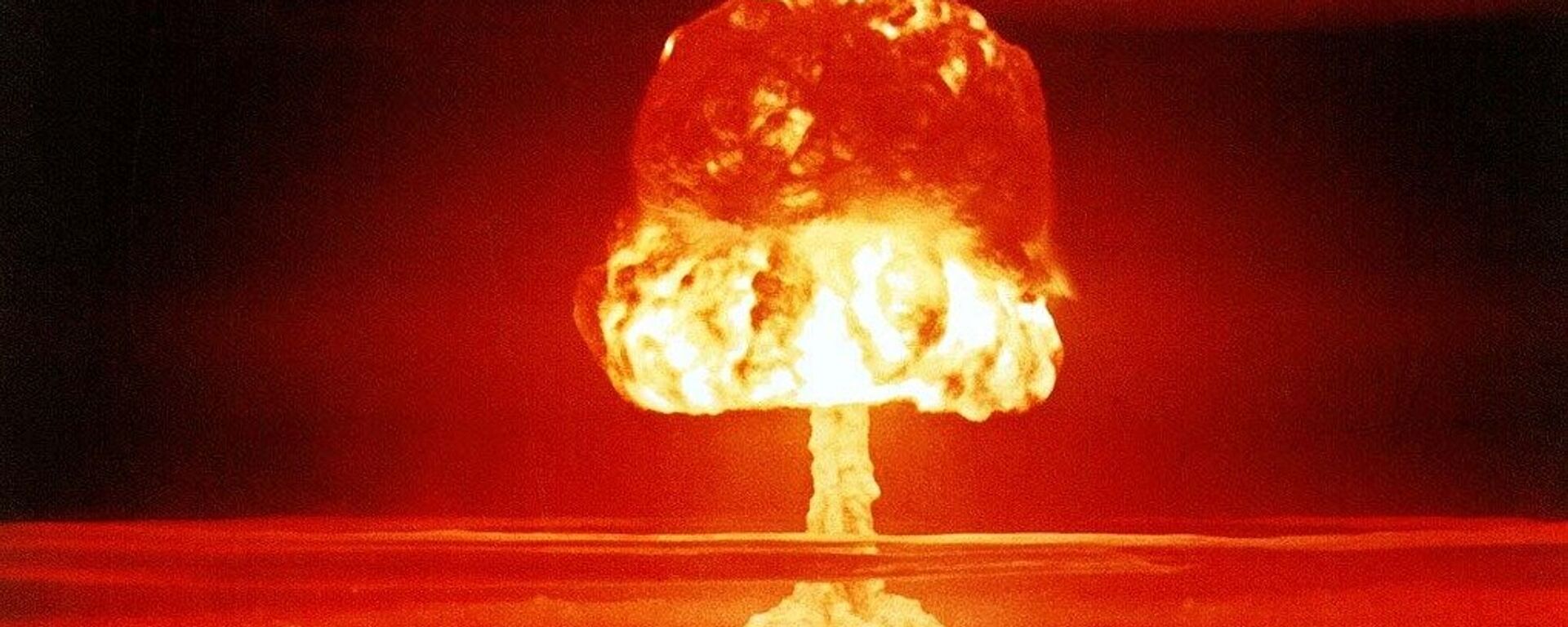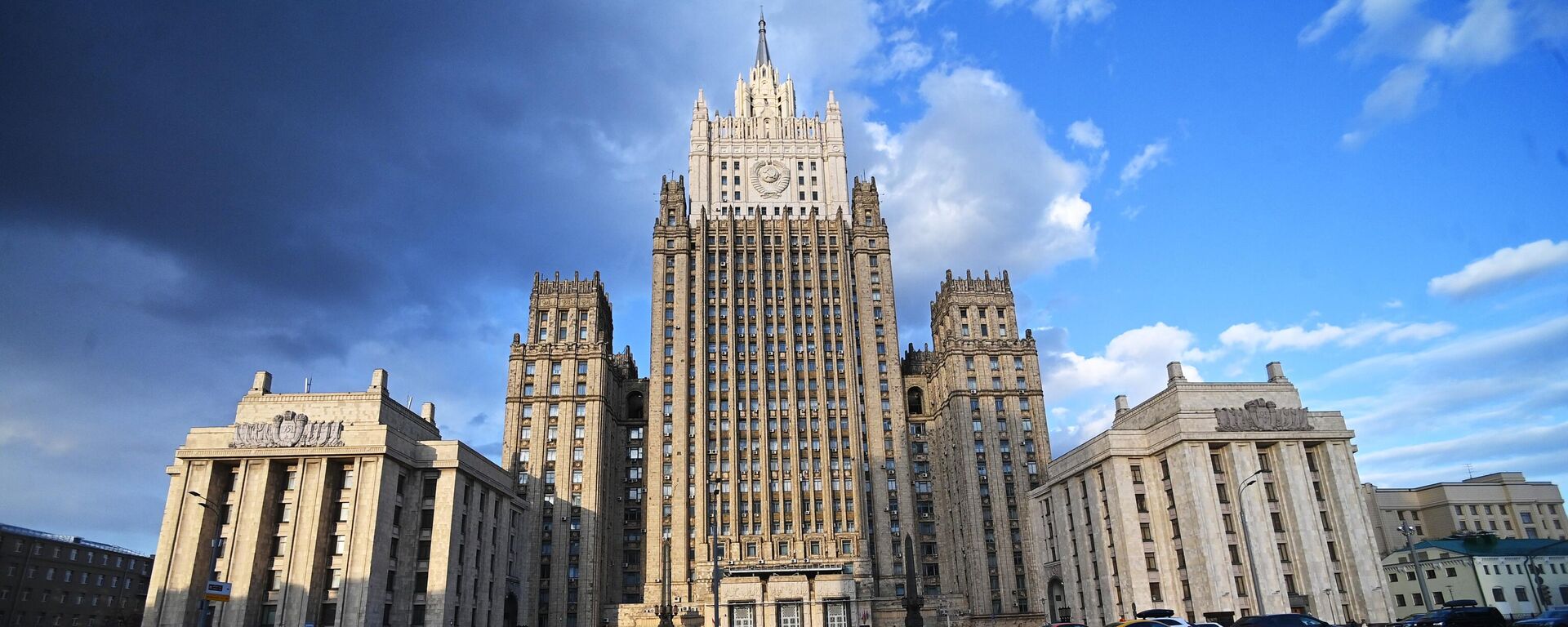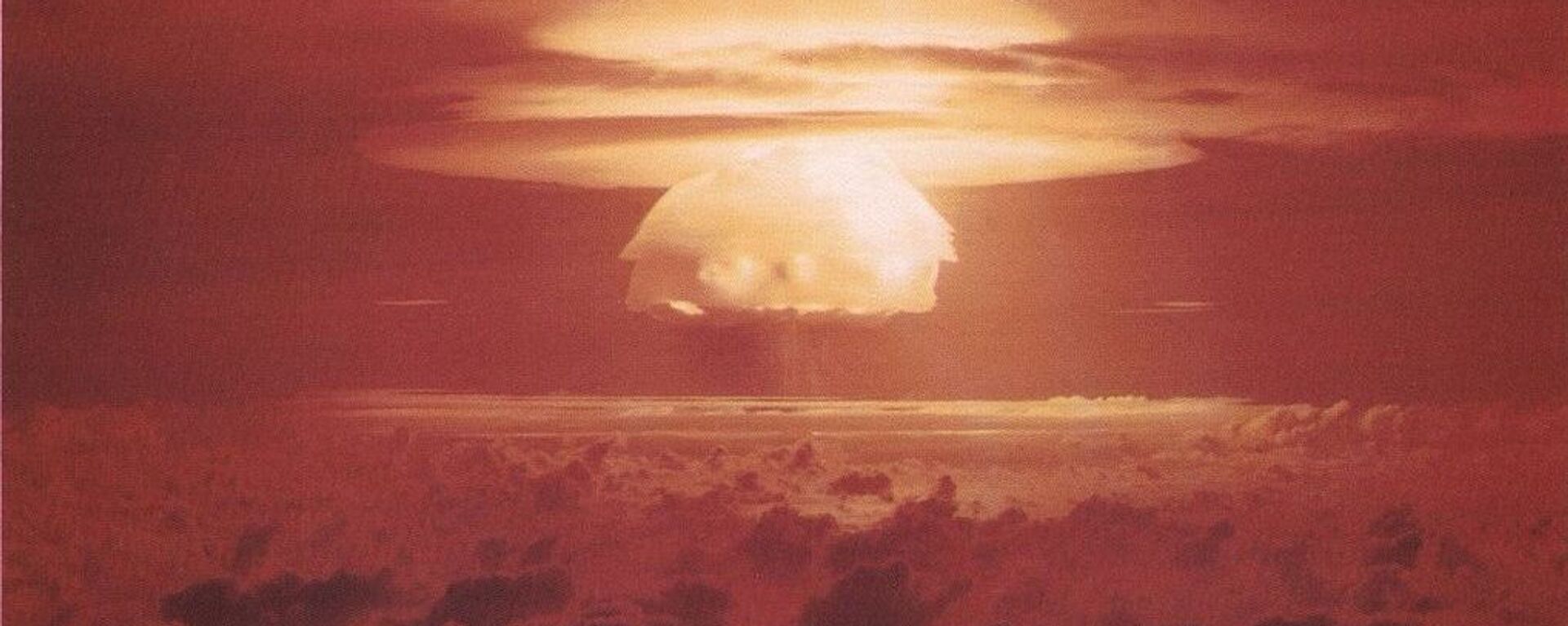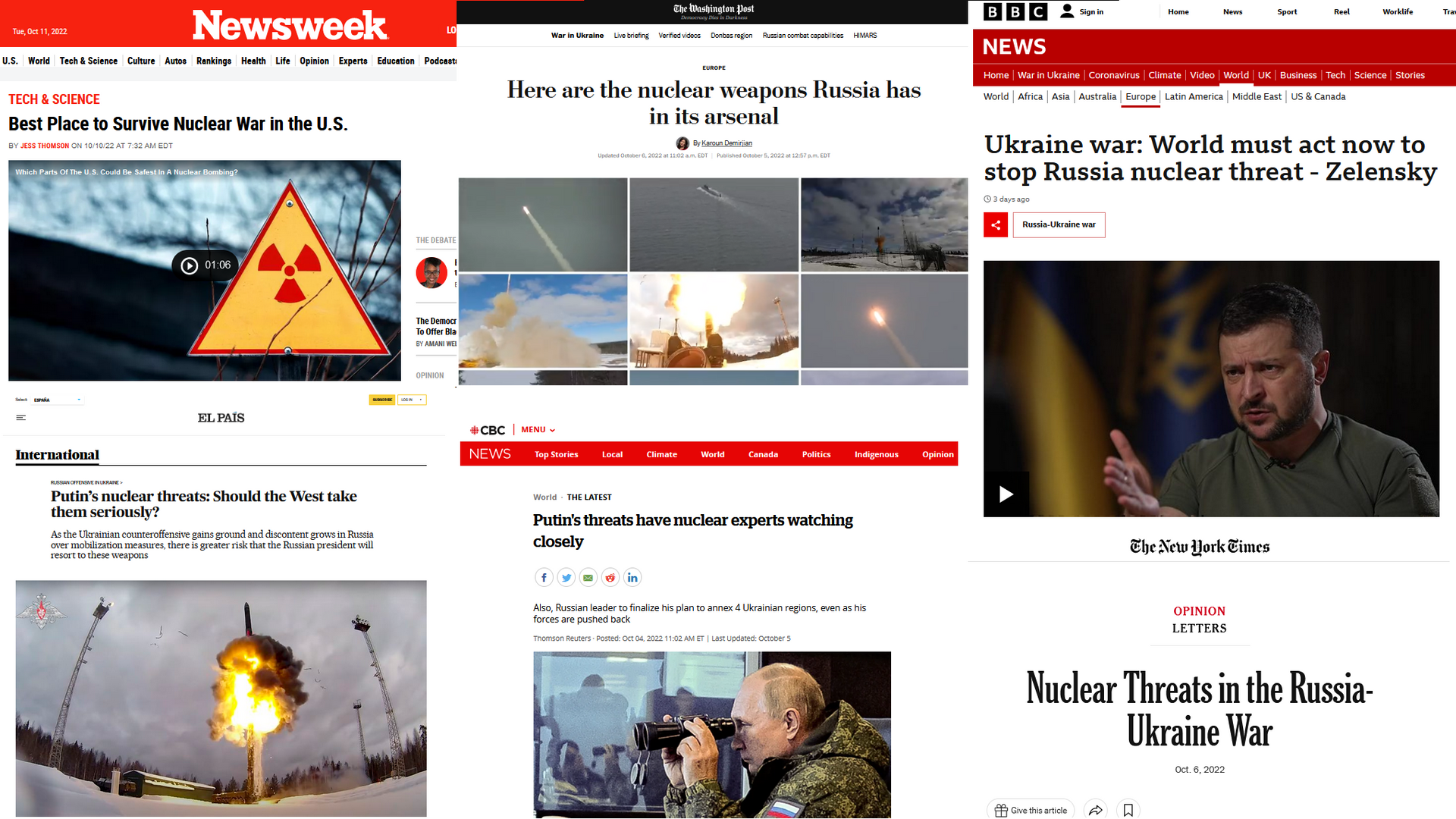https://sputnikglobe.com/20221011/no-the-worlds-not-heading-for-a-nuclear-apocalypse-heres-why-1101734791.html
No, The World's Not Heading For a Nuclear Apocalypse: Here’s Why
No, The World's Not Heading For a Nuclear Apocalypse: Here’s Why
Sputnik International
These days, it seems just about every mainstream outlet is spouting dire warnings about the threat of the Ukraine crisis snowballing into a nuclear apocalypse... 11.10.2022, Sputnik International
2022-10-11T17:57+0000
2022-10-11T17:57+0000
2022-10-11T19:58+0000
sputnik explains
nuclear
nuclear weapons
russia
us
joe biden
reports
media
fear-mongering
https://cdn1.img.sputnikglobe.com/img/07e6/0a/0b/1101734644_2:0:2046:1150_1920x0_80_0_0_4a3053f7b00f5f866c08f34c090b938a.png
The Western media space has been saturated with reports on the dangers of a nuclear war, particularly after President Vladimir Putin’s (deliberately misread) warning late last month that Russia would retaliate to nuclear aggression, and US President Joe Biden’s comments last week that the prospects of nuclear “Armageddon” were today higher than at any other time since the 1962 Cuban Missile Crisis.Russia is (surprise, surprise!) the culprit in virtually every report, with the logic being that a Russian defeat on the battlefield in its special military operation in Ukraine might motivate an “emotionally unstable” Russian leadership to push the button and end humanity.“Ukraine war: World must act now to stop Russia nuclear threat – Zelensky,” a BBC piece warned Saturday, with the Ukrainian president telling the broadcaster that Moscow had begun to “prepare their society” for nuke use. Ironically, Volodymyr Zelensky himself got called out earlier in the week after appearing to call for a nuclear “preemptive strike” against Russia. He later said that his comments were a mistranslation, and that he meant a “preemptive strike” of sanctions.“Putin’s threats have nuclear experts watching closely,” Canada’s national broadcaster, the CBC, wrote in a piece last week, accompanying the article with a picture of a tough-looking Putin in military fatigues looking through a pair of binoculars. CBC’s experts expressed little doubt at Moscow’s willingness to use the weapons and, pointing to Kiev’s distribution of potassium iodine pills, explained that the pills can help block the absorption of harmful radiation by the thyroid gland after a nuclear attack.“How likely is a Russian nuclear strike in Ukraine?” NPR pondered in a clickbaity article on October 4. An expert from Harvard University "explained" that Russia was “threatening” to break the world’s “77-year tradition, some call it a taboo, of non-use of nuclear weapons.” He tactfully failed to mention that the United States is the only country to have ever used nukes – when it incinerated a pair of Japanese cities during the closing days of World War II, killing up to 215,000 people.Other outlets offered handy info and tips, with Spain’s El Pais and The Washington Post providing primers on Russia’s nuclear arsenal, while Polish media reported on government preparations for “the darkest scenario” by checking the readiness of the nation’s network of bomb shelters. Not to be outdone, Newsweek explained to readers the safest places to be and where to hide in the event of a nuclear blast, saying “the best place to go…depends on where the bomb is targeted, as well as the size of the nuclear weapons, the time of year, the weather conditions, and a variety of other factors.”Did Everybody Forget How to Read?In the face of the media’s growing nuclear frenzy, a senior Russian Foreign Ministry official turned to Sputnik to set the record straight.What does Ryabkov mean? Well, Russia’s nuclear doctrine is no secret. In fact, in June 2020, for the first time in the nation’s history and in the interests of transparency, Moscow published the document governing the nation’s nuclear weapons use policy in full (you can find it here).To quote at length:“The Russian Federation considers nuclear weapons exclusively as a means of deterrence, their use being an extreme and compelled measure, and takes all necessary efforts to reduce nuclear threat and prevent aggravation of interstate relations, that could trigger military conflicts, including nuclear ones.”…“Nuclear deterrence is ensured by the presence in the Armed Forces of the Russian Federation of combat-ready forces and means that are capable to inflict guaranteed unacceptable damage on a potential adversary through employment of nuclear weapons in any circumstances, as well as by the readiness and resolve of the Russian Federation to use such weapons.”And here’s the crucial bit:Did everybody catch that? One more time for the fearmongers in the media and the White House out there:Russia will not use nukes unless nukes or other WMDs are used against it or its allies first, or if a conventional attack so severe that the country’s very existence is threatened is unleashed against it. This applies to all nuclear weapons, with no distinction made in the document between tactical (battlefield) nukes and strategic ones (i.e. those able to cause horrific, widespread destruction –and potentially end human life on this planet).And the Other Guy?But what about the US? Amid the recent string of reports from officials, think tank eggheads and media about Russia’s dastardly plans to use nuclear weapons preemptively and unprovoked, surely America’s own doctrine must be peace-loving, reasonable, and grounded in the realization that a nuclear war cannot be won and should never be fought. Right?Turns out, not so much. The 2018 Nuclear Posture Review (NPR) – the document outlining policy on nuclear weapons and outlining a list of nuclear threats to the nation, explicitly states that the United States has not and will not commit to a strategy of no first use:“In addition, the United States will maintain a portion of its nuclear forces on alert day-to-day, and retain the option of launching those forces promptly. This posture maximizes decision time and preserves the range of US response options. It also makes clear to potential adversaries that they have no confidence in strategies intended to destroy our nuclear deterrent forces in a surprise first strike,” the document adds.That’s not all. Page 54 mentions the Pentagon’s plans to expand the “flexibility” of its nuclear capabilities to include new “low-yield options” (i.e. smaller nuclear bombs), characterizing the move as an “important” step “for the preservation of credible deterrence against regional aggression.”“Consequently, the United States will maintain, and enhance as necessary, the capability to forward deploy nuclear bombers and DCA [dual-capable aircraft] around the world. We are committed to upgrading DCA with the nuclear-capable F-35 aircraft. We will work with NATO to best ensure – and improve where needed – the readiness, survivability, and operational effectiveness of DCA based in Europe,” the document states.Citing the range of threats arrayed against the United States by Russia, China, North Korea, and Iran, the document emphasizes that the US reserves the right to “continue to field a range of conventional and nuclear capabilities able to hold such targets at risk,” hinting at the possibility of using nukes even against conventional adversaries, unless they are a party to the Non-Proliferation Treaty and deemed to be “in compliance with their nuclear non-proliferation obligations.”The Biden administration submitted an update to the nuclear doctrine in March 2022, with its contents remaining largely under wraps. However, according to a "fact sheet" put out by the administration, the policy will not be altered to include a "no first use" pledge.Given this information, gleaned from the official policy documents of the nuclear superpowers, perhaps it’s time for Western media to ask the White House a few uncomfortable questions – like why Washington won’t pledge not to use nukes first, instead of penning alarmist report after report on the nuclear dangers supposedly emanating from the Kremlin.Other Nuclear PowersBesides Russia and the US, other nuclear weapons states include China, France, the United Kingdom, India, Pakistan, North Korea and Israel (allegedly). China and India are the only countries that maintain a nuclear no first use policy.Pakistan has refused to adopt a similar policy, with its civilian and military leaders stating repeatedly over the decades that the country reserves the right to use "any weapon in [its] arsenal" if attacked. French policy is similarly vague, with its official doctrine stating that nukes can be used to protect the nation's "vital interests," including in the face of an enemy conventional, chemical, biological or even cyber attacks. In the UK, successive defense secretaries in the past two decades have stressed that the country could use nuclear weapons as a "first strike" weapon. In August, Liz Truss confirmed her "readiness" to press the button.North Korea officially proclaimed itself a nuclear weapons state last month, with its doctrine allowing for nukes to be used as a "powerful means for defending the sovereignty, territorial integrity and fundamental interests of the state."Finally, Israel, which neither confirms nor denies its nuclear weapons status in a policy known as 'deliberate ambiguity', is believed to adhere to what's known as the 'Samson Option' - a deterrence strategy named after the biblical figure judge Samson. The doctrine allows for nukes to be used if conventional defenses fail and the country is threatened with destruction. Israel is speculated to have contemplated this option during the Yom Kippur War of 1973, and to have placed nuclear landmines in the occupied Golan Heights in the 1980s.Message of Hope?Whatever tactical and strategic changes take place in Ukraine, Taiwan, or any other existing or emerging global hot spot in the coming months and years, the world’s major nuclear powers have offered at least some reassurance that they are not contemplating nuclear Armageddon as a first resort.In a joint statement in January, Russia, the United States, China, France, and Britain restated their commitment to maintaining and strengthening “national measures to prevent unauthorized or unintended use of nuclear weapons,” and reiterated “the validity of our previous statements on de-targeting, reaffirming that none of our nuclear weapons are targeted at each other or at any other state.”Take that for what it’s worth.
https://sputnikglobe.com/20221006/peskov-urges-entire-world-to-take-note-of-zelenskys-call-for-preventive-nuclear-strike-on-russia-1101582414.html
https://sputnikglobe.com/20221011/russia-does-not-threaten-anyone-with-nuclear-weapons-foreign-ministry-1101716787.html
https://sputnikglobe.com/20220925/us-threatens-russia-with-catastrophic-consequences-if-it-nukes-ukraine-distorts-putins-warning-1101212446.html
https://sputnikglobe.com/20220811/stratcom-head-us-working-furiously-to-formulate-new-deterrence-strategy-against-russia-china-1099494374.html
https://sputnikglobe.com/20220826/nuclear-five-could-become-base-for-new-disarmament-platform---russian-official-1100006404.html
russia
Sputnik International
feedback@sputniknews.com
+74956456601
MIA „Rosiya Segodnya“
2022
News
en_EN
Sputnik International
feedback@sputniknews.com
+74956456601
MIA „Rosiya Segodnya“
Sputnik International
feedback@sputniknews.com
+74956456601
MIA „Rosiya Segodnya“
sputnik explains, nuclear, nuclear weapons, russia, us, joe biden, reports, media, fear-mongering
sputnik explains, nuclear, nuclear weapons, russia, us, joe biden, reports, media, fear-mongering
No, The World's Not Heading For a Nuclear Apocalypse: Here’s Why
17:57 GMT 11.10.2022 (Updated: 19:58 GMT 11.10.2022) These days, it seems just about every mainstream outlet is spouting dire warnings about the threat of the Ukraine crisis snowballing into a nuclear apocalypse, with piece after piece listing stats on nuke arsenals, providing duck and cover instructions and other info. It’s time for everybody to calm down and take a chill pill. Sputnik explains why.
The Western media space has been saturated with reports on the dangers of a nuclear war, particularly after President Vladimir Putin’s (
deliberately misread) warning late last month that Russia would retaliate to nuclear aggression, and US President Joe Biden’s
comments last week that the prospects of nuclear “Armageddon” were today higher than at any other time since the 1962 Cuban Missile Crisis.
Russia is (surprise, surprise!) the culprit in virtually every report,
with the logic being that a Russian defeat on the battlefield in its special military operation in Ukraine might motivate an “emotionally unstable” Russian leadership to push the button and end humanity.
“Ukraine war: World must act now to stop Russia nuclear threat – Zelensky,” a BBC piece
warned Saturday, with the Ukrainian president telling the broadcaster that Moscow had begun to “prepare their society” for nuke use. Ironically, Volodymyr Zelensky himself
got called out earlier in the week after appearing to call for a nuclear “preemptive strike” against Russia. He later said that his comments were a mistranslation, and that he meant a “preemptive strike” of sanctions.

6 October 2022, 17:37 GMT
“Putin’s threats have nuclear experts watching closely,” Canada’s national broadcaster, the CBC,
wrote in a piece last week, accompanying the article with a picture of a tough-looking Putin in military fatigues looking through a pair of binoculars. CBC’s experts expressed little doubt at Moscow’s willingness to use the weapons and, pointing to Kiev’s distribution of potassium iodine pills, explained that the pills can help block the absorption of harmful radiation by the thyroid gland after a nuclear attack.
“How likely is a Russian nuclear strike in Ukraine?” NPR
pondered in a clickbaity article on October 4. An expert from Harvard University "explained" that Russia was “threatening” to break the world’s “77-year tradition, some call it a taboo, of non-use of nuclear weapons.” He tactfully failed to mention that the United States is the only country to have ever used nukes – when it incinerated a pair of Japanese cities during the closing days of World War II, killing up to 215,000 people.
Other outlets offered handy info and tips, with Spain’s
El Pais and
The Washington Post providing primers on Russia’s nuclear arsenal, while Polish media
reported on government preparations for “the darkest scenario” by checking the readiness of the nation’s network of bomb shelters. Not to be outdone, Newsweek
explained to readers the safest places to be and where to hide in the event of a nuclear blast, saying “the best place to go…depends on where the bomb is targeted, as well as the size of the nuclear weapons, the time of year, the weather conditions, and a variety of other factors.”
Did Everybody Forget How to Read?
In the face of the media’s growing nuclear frenzy, a senior Russian Foreign Ministry official turned to Sputnik to set the record straight.
“Amid the events taking place in Ukraine, the United States and states that depend on it are actively introducing nuclear rhetoric into circulation. They are trying to present it as if our country is preparing to launch strikes using weapons of mass destruction. Once again, we have to explain that Russia does not threaten anyone with the use of nuclear weapons,” Deputy Foreign Minister Sergei Ryabkov told Sputnik in an interview on Tuesday.

11 October 2022, 10:47 GMT
What does Ryabkov mean? Well, Russia’s nuclear doctrine is no secret. In fact, in June 2020, for the first time in the nation’s history and in the interests of transparency, Moscow published the document governing the nation’s nuclear weapons use policy in full (you can find it
here).
“The Russian Federation considers nuclear weapons exclusively as a means of deterrence, their use being an extreme and compelled measure, and takes all necessary efforts to reduce nuclear threat and prevent aggravation of interstate relations, that could trigger military conflicts, including nuclear ones.”
“Nuclear deterrence is ensured by the presence in the Armed Forces of the Russian Federation of combat-ready forces and means that are capable to inflict guaranteed unacceptable damage on a potential adversary through employment of nuclear weapons in any circumstances, as well as by the readiness and resolve of the Russian Federation to use such weapons.”
And here’s the crucial bit:
“The Russian Federation reserves the right to use nuclear weapons in response to the use of nuclear and other types of weapons of mass destruction against it and/or its allies, as well as in the event of aggression against the Russian Federation with the use of conventional weapons when the very existence of the state is in jeopardy.”
Did everybody catch that? One more time for the fearmongers in the media and the White House out there:
Russia will not use nukes unless nukes or other WMDs are used against it or its allies first, or if a conventional attack so severe that the country’s very existence is threatened is unleashed against it. This applies to all nuclear weapons, with no distinction made in the document between tactical (battlefield) nukes and strategic ones (i.e. those able to cause horrific, widespread destruction –and potentially end human life on this planet).
But what about the US? Amid the recent string of reports from officials, think tank eggheads and media about Russia’s dastardly plans to use nuclear weapons preemptively and unprovoked, surely America’s own doctrine must be peace-loving, reasonable, and grounded in the realization that a nuclear war cannot be won and should never be fought. Right?
Turns out, not so much. The 2018
Nuclear Posture Review (NPR) – the document outlining policy on nuclear weapons and outlining a list of nuclear threats to the nation, explicitly states that the United States has not and will not commit to a strategy of no first use:
“To help preserve deterrence and the assurance of allies and partners, the United States has never adopted a ‘no first use’ policy and, given the contemporary threat environment, such a policy is not justified today. It remains the policy of the United States to retain some ambiguity regarding the precise circumstances that might lead to a US nuclear response,” page 22 states.
“In addition, the United States will maintain a portion of its nuclear forces on alert day-to-day, and retain the option of launching those forces promptly. This posture maximizes decision time and preserves the range of US response options. It also makes clear to potential adversaries that they have no confidence in strategies intended to destroy our nuclear deterrent forces in a surprise first strike,” the document adds.

25 September 2022, 16:09 GMT
That’s not all. Page 54 mentions the Pentagon’s plans to expand the “flexibility” of its nuclear capabilities to include new “low-yield options” (i.e. smaller nuclear bombs), characterizing the move as an “important” step “for the preservation of credible deterrence against regional aggression.”
“Consequently, the United States will maintain, and enhance as necessary, the capability to forward deploy nuclear bombers and DCA [dual-capable aircraft] around the world. We are committed to upgrading DCA with the nuclear-capable F-35 aircraft. We will work with NATO to best ensure – and improve where needed – the readiness, survivability, and operational effectiveness of DCA based in Europe,” the document states.
“Additionally, in the near-term, the United States will modify a small number of existing SLMB [submarine-launched ballistic missile] warheads to provide a low-yield option, and in the longer term, pursue a modern nuclear-armed sea-launched cruise missile (SLCM). Unlike DCA, a low-yield SLBM warhead and SLCM will not require or rely on host nation support to provide a deterrent effect. They will provide additional diversity in platforms, range, and survivability, and a valuable hedge against future nuclear ‘break out’ scenarios,” the NPR adds.
Citing the range of threats arrayed against the United States by Russia, China, North Korea, and Iran, the document emphasizes that the US reserves the right to “continue to field a range of conventional and nuclear capabilities able to hold such targets at risk,” hinting at the possibility of using nukes even against conventional adversaries, unless they are a party to the Non-Proliferation Treaty and deemed to be “in compliance with their nuclear non-proliferation obligations.”
The Biden administration submitted an update to the nuclear doctrine in March 2022, with its contents remaining largely under wraps. However,
according to a "fact sheet" put out by the administration, the policy will not be altered to include a "no first use" pledge.
Given this information, gleaned from the official policy documents of the nuclear superpowers, perhaps it’s time for Western media to ask the White House a few uncomfortable questions – like why Washington won’t pledge not to use nukes first, instead of penning alarmist report after report on the nuclear dangers supposedly emanating from the Kremlin.

11 August 2022, 23:36 GMT
Besides Russia and the US, other nuclear weapons states include China, France, the United Kingdom, India, Pakistan, North Korea and Israel (
allegedly). China and India are the only countries that maintain a
nuclear no first use policy.
Pakistan has refused to adopt a similar policy, with its civilian and military leaders
stating repeatedly over the decades that the country reserves the right to use
"any weapon in [its] arsenal" if attacked. French policy is similarly vague, with its official doctrine stating that nukes can be used to protect the nation's "vital interests," including in the face of an enemy conventional, chemical, biological
or even cyber attacks. In the UK, successive defense secretaries in the past two decades have stressed that the country could use nuclear weapons
as a "first strike" weapon. In August, Liz Truss confirmed her
"readiness" to press the button.
North Korea officially proclaimed itself a nuclear weapons state last month, with its doctrine
allowing for nukes to be used as a "powerful means for defending the sovereignty, territorial integrity and fundamental interests of the state."
Finally, Israel, which neither confirms nor denies its nuclear weapons status in a policy known as 'deliberate ambiguity', is believed to adhere to what's known as the
'Samson Option' - a deterrence strategy named after the biblical figure judge Samson. The doctrine allows for nukes to be used if conventional defenses fail and the country is threatened with destruction. Israel is speculated to have
contemplated this option during the Yom Kippur War of 1973, and to have placed nuclear landmines in the occupied Golan Heights in the 1980s.
Whatever tactical and strategic changes take place in Ukraine, Taiwan, or any other existing or emerging global hot spot in the coming months and years, the world’s major nuclear powers have offered at least some reassurance that they are not contemplating nuclear Armageddon as a first resort.
In a
joint statement in January, Russia, the United States, China, France, and Britain restated their commitment to maintaining and strengthening “national measures to prevent unauthorized or unintended use of nuclear weapons,” and reiterated “the validity of our previous statements on de-targeting, reaffirming that none of our nuclear weapons are targeted at each other or at any other state.”
“We affirm that a nuclear war cannot be won and must never be fought. As nuclear use would have far-reaching consequences, we also affirm that nuclear weapons – for as long as they continue to exist – should serve defensive purposes, deter aggression, and prevent war,” the five nations pledged.
Take that for what it’s worth.

26 August 2022, 00:06 GMT








